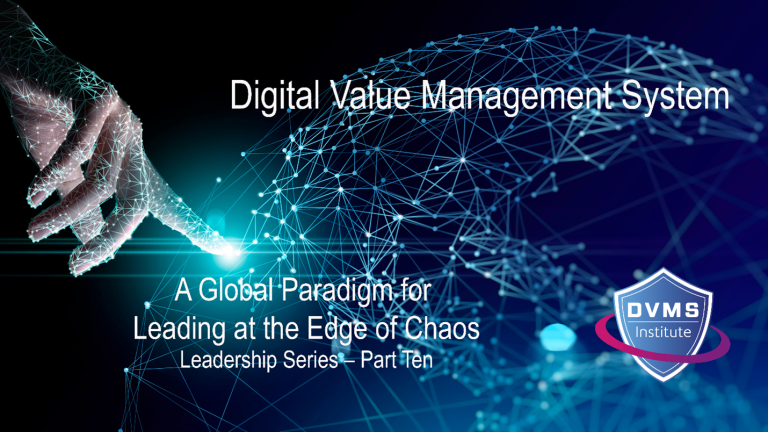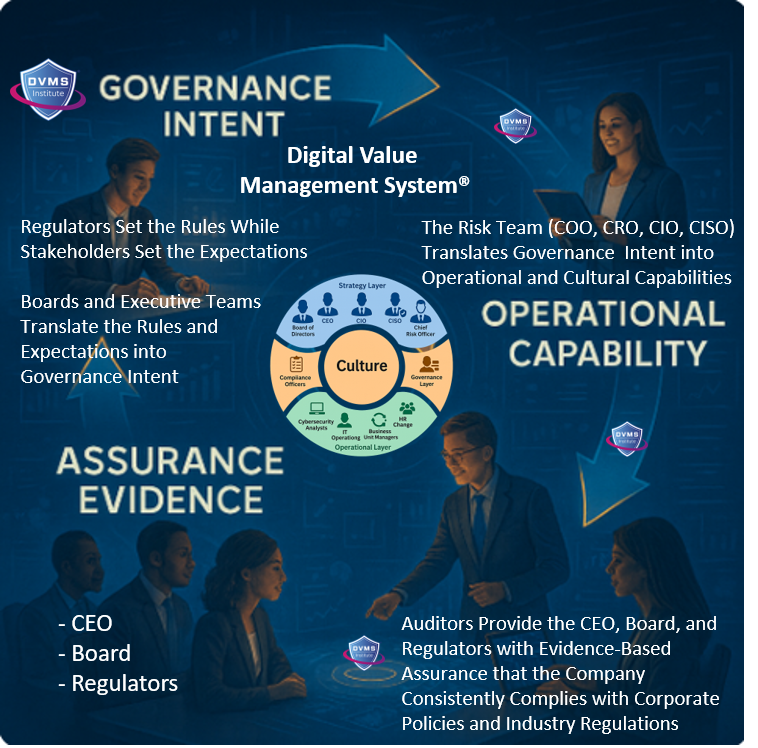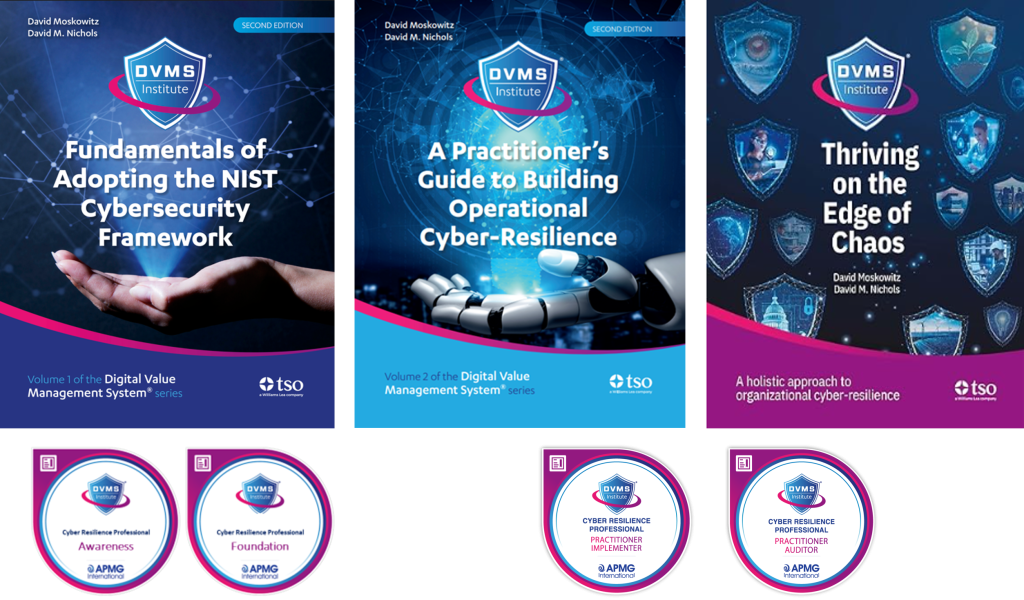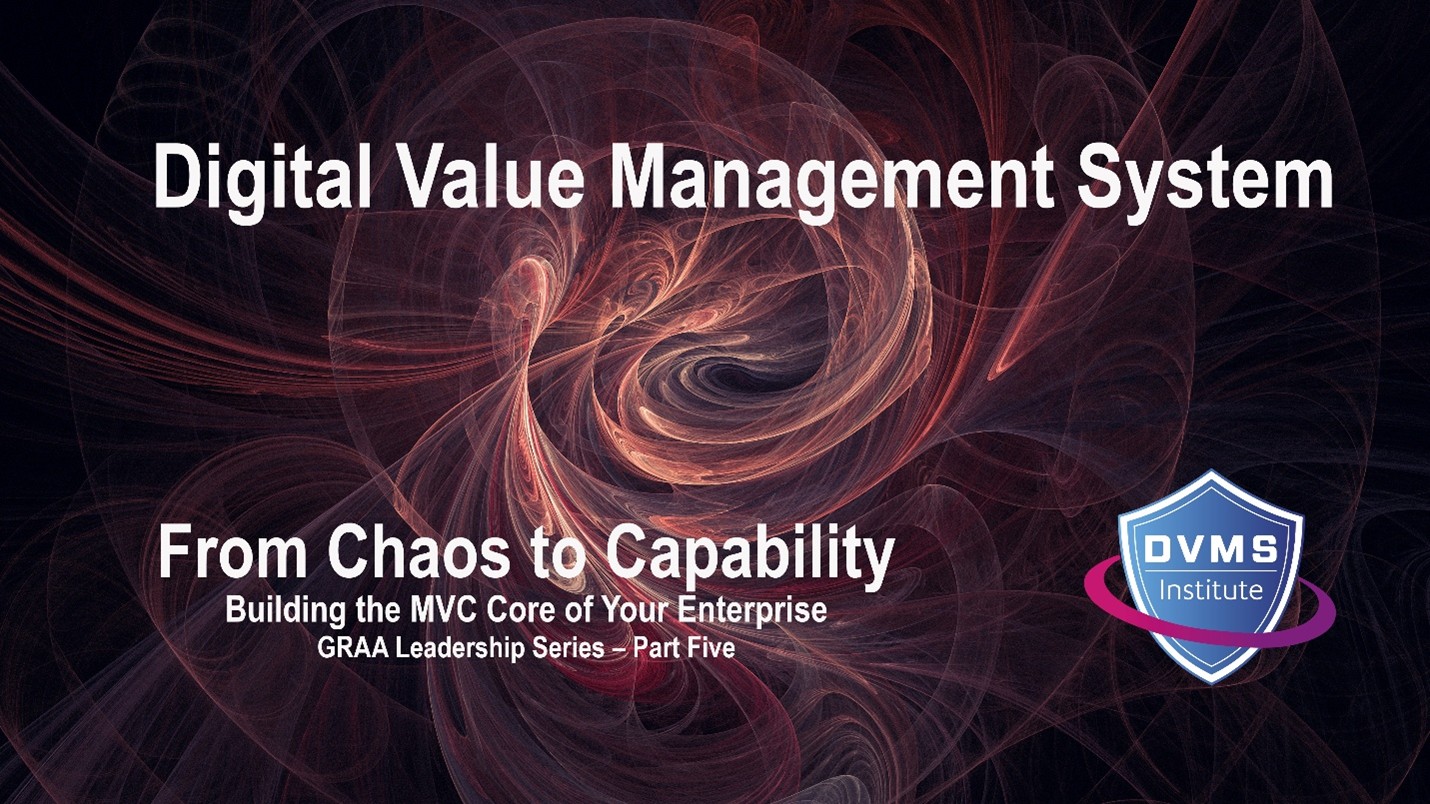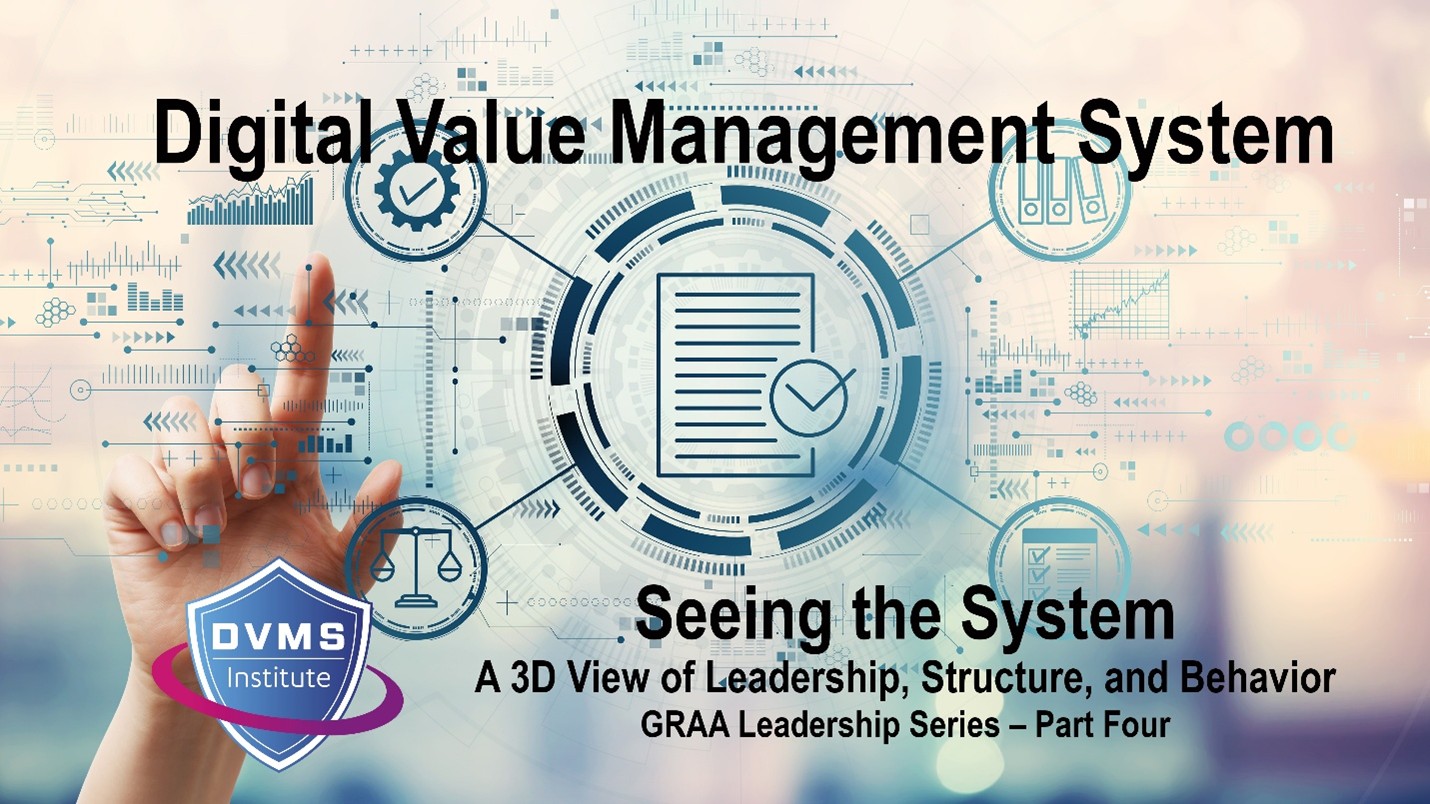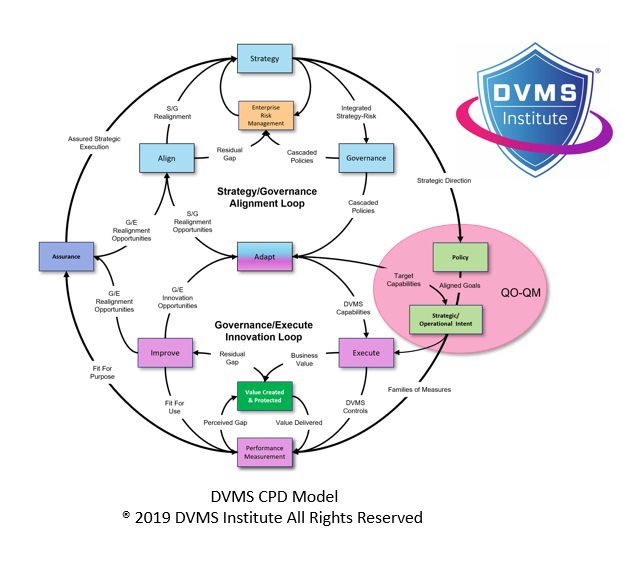A Global Paradigm for Leading on the Edge of Chaos – A Leadership Call to Action – Part Ten
David Nichols – Co-Founder and Executive Director of the DVMS Institute
Culmination at the Edge of Chaos
Over several parts of this series, we have walked together along a path that began with principles and steadily moved outward toward practice and new frontiers.
In Part Six, we explored orchestration — how leadership aligns value, risk, and culture at the edge of chaos. In Part Seven, we entered the arena of practice: digital transformation, mergers and acquisitions, supply chains, and enterprise resilience programs. Part Eight widened the frontier into AI adoption, digital ethics, stakeholder trust, and societal expectations. In Part Nine, we zeroed in on supply webs, emphasizing containment and evidence-based relationships as leadership imperatives.
Now, in Part Ten, we reach a culmination. I’ll keep using the full term’ edge of chaos,’ but, as in earlier parts, sometimes shorten it to just ‘the edge’ for simplicity. Here, we weave together the themes of this series into a global leadership model that views the edge of chaos not as a temporary state but as the permanent environment for leadership in the digital age.
This final paper is not about surviving volatility. It is about learning to thrive in it.
The Edge of Chaos as a Global Condition
The edge of chaos has never been episodic. It is constant, defining the environment in which leaders must operate.
Complex interdependencies — technological, economic, geopolitical, and societal — mean a disruption in one area quickly affects others. A cyberattack in one sector destabilizes healthcare. A geopolitical conflict reorders supply chains and reshapes energy markets. A climate event halts production, disrupts logistics, and triggers regulatory backlash.
In this reality, resilience and fragility coexist—no leader, organization, or nation functions in isolation. The edge of chaos defines the global state of leadership.
The DVMS approach offers a way to navigate this environment. It redefines governance, resilience, and assurance (GRA) not as compliance checklists but as results of leadership alignment. Resiliency develops naturally when leadership intent, structures, and behaviors are aligned. When they are not, fragility increases.
Orchestration at Scale
At the global edge of chaos, leadership orchestration must scale beyond the boundaries of a single organization.
This orchestration is less about control and more about composition. Leaders must harmonize diverse actors — governments, industries, NGOs, regulators, communities — like a conductor guiding an orchestra into coherence without dictating every note.
Consider a global climate crisis. No single firm or nation can resolve it. Yet resilience emerges when leaders orchestrate across ecosystems, pooling innovation, aligning risk frameworks, and reinforcing shared cultural commitments. The same applies to cyber incidents, pandemics, or systemic financial shocks.
Here, assimilation re-emerges as the key differentiator. Leaders cannot simply align with existing systems; they must integrate diverse cultural norms, regulatory regimes, and stakeholder expectations into a unified global stance. This is not about cultural uniformity but creating harmony — ensuring that different expressions support rather than oppose shared goals.
Containment and Evidence as Non-Negotiables
Containment, introduced in Part Nine, extends into the global framework. Leaders cannot rely solely on assurances; they must require measurable proof of resilience.
Containment is not just a supply web principle. It also applies to global partnerships, regulatory compliance, and internal functions. Leaders must ask: Can this partner, regulator, or internal unit demonstrate, with evidence, that they can meet our needs under stress?
Proof replaces assumption. Transparency replaces blind trust. Evidence replaces narrative.
The Adaptive Edge Platform enhances this stance. Guided by Kaia, the Adaptive Edge Platform reveals interdependencies across borders and ecosystems that no leader could identify alone. Kaia does not make decisions; she advises by simplifying the systems map, highlighting gaps, and clarifying the hard and soft skills needed to address them.
Containment and evidence serve as the foundation of legitimacy at the chaotic edge of the world. Without them, resilience is merely performative. With them, resilience turns into reality.
The Role of Culture in the Global Paradigm
Culture remains the key. It acts as the bridge between leadership intent and organizational execution. Globally, culture shouldn’t mean uniformity. Instead, it should mean congruence.
A global company might state values like transparency, fairness, or sustainability. In one place, these values are shown through local community involvement practices. In addition, they are demonstrated through adherence to regulations and dialogue with stakeholders. Different ways of expressing these values are acceptable — even preferred — if they match the leadership’s goals.
Leaders must exemplify this consistency. They cannot just proclaim values; they must show them through actions. Culture grows into global resilience when it is varied in expression and unified in purpose.
Once again, assimilation is crucial. Leaders must integrate global expectations into local practices, forming a consistent cultural narrative that enhances resilience. When this assimilation is lacking, contradictions weaken trust, legitimacy, and effectiveness.
Practical Tools for Global Leadership
Global leadership at the edge of chaos cannot remain theoretical. Executives require tools that translate complexity into clarity.
The Z-axis audit (introduced in Part Six) must be extended to a global scale:
- Does our leadership intent (Z-axis) align with structures (Y-axis) and behaviors (X-axis) across geographies?
- Are contradictions emerging across jurisdictions that weaken resilience?
- Are we rewarding behaviors that reinforce congruence, or tolerating those that create dissonance?
The CPD Model also scales globally:
- Create: innovation that respects cultural diversity and leverages global collaboration.
- Protect: resilience embedded across borders, built on containment and evidence.
- Deliver: coherence that sustains trust globally without crushing local adaptation.
The Adaptive Edge Platform’s federated layer improves these tools. Kaia gives leaders visibility into global interconnectedness. She highlights where leadership goals don’t match organizational structures, cultural behaviors weaken resilience, and skills like geopolitical literacy, regulatory navigation, empathy, and diplomacy need development. By simplifying the system’s network into a clear route, Kaia helps leaders confidently steer through the chaos at the edge of the world.
Patterns of Leadership at the Global Edge of Chaos
Leadership cannot be reduced to a formula in complex systems. Outcomes emerge from the interactions of countless actors, structures, and behaviors. This is why leaders at the global edge of chaos must constantly look for emergent properties patterns that reveal whether resilience is growing or fragility is taking root.
Leaders who succeed do so by integrating, assimilating, and demanding evidence. They integrate across borders, recognizing that resilience is a shared trait. They assimilate various cultural norms, regulatory frameworks, and stakeholder expectations into a unified stance, enabling global systems to operate with harmony rather than conflict. And they demand evidence — not as bureaucracy, but as proof that resilience is genuine.
Consider how some global manufacturers responded to pandemic-driven supply shocks. The ones that recovered fastest weren’t those with the longest supplier lists but those that demanded demonstrable resilience from their networks. They required proof of recovery plans, tested supplier redundancy under stress, and cultivated transparent escalation channels. When bottlenecks appeared, they already knew where vulnerabilities lay and could adapt quickly. Competitors relying on assurances rather than evidence found themselves paralyzed when their “redundant” suppliers all failed in the same way.
These leaders also see culture as alignment rather than uniformity. They do not enforce a single global culture; instead, they foster harmony between intent, structures, and behaviors across different contexts. For example, multinational companies navigating the European Union’s GDPR and California’s CCPA quickly realized that viewing data privacy merely as compliance led to inconsistency and mistrust. Those who reframe privacy as a cultural value — expressed differently in Brussels and Silicon Valley but rooted in a shared goal of transparency and accountability — earned trust worldwide. Those who viewed regulations as local burdens created dissonance and reputational risk.
In contrast, leaders who fail are those who cling to silos. They manage locally, assume resilience instead of demanding proof, and treat global interdependencies as outside issues—things for others to handle. A clear example appeared in the early months of the pandemic, when some national healthcare systems hoarded supplies and restricted exports. What seemed to be local protection quickly backfired: trust eroded, critical supplies were delayed, and interconnected partners started seeking more dependable relationships elsewhere. Leadership based on silos intensified this fragility.
The core idea is simple yet profound: resilience and legitimacy at the edge of chaos are emergent results of leadership alignment on a large scale. When leaders coordinate intent, structures, and behaviors across borders and ecosystems, resilience develops naturally. When they fail to integrate, assimilate, and require evidence, fragility increases, and legitimacy diminishes.
Thriving at the Edge of Chaos
This series started with orchestration at the organizational level and has gradually expanded to the global paradigm. Along the way, we have learned that leadership at the edge of chaos is not about resisting volatility but embracing it.
Leaders must coordinate value, risk, and culture across borders, ecosystems, and societies to succeed. They must demand evidence and containment, integrate cultural diversity into harmony, and demonstrate transparency through their own actions.
Tools like the DVMS approach and the Adaptive Edge Platform make complexity manageable, demonstrate resilience, and allow leadership to fulfill its highest role.
The edge of chaos is no longer a place we occasionally encounter. It is our daily environment. And it is here, at the edge of chaos, that leadership must learn to adapt and thrive.
About the Author

Dave is the Executive Director of the DVMS Institute.
Dave spent his “formative years” on US Navy submarines. There, he learned complex systems, functioning in high-performance teams, and what it takes to be an exceptional leader. He took those skills into civilian life and built a successful career leading high-performance teams in software development and information service delivery.
Digital Value Management System® (DVMS)
Digital organizations don’t fail because they lack frameworks and practices.
They fail because those frameworks and practices operate in silos.
The Digital Value Management System® (DVMS) integrates fragmented frameworks and practices such as NISTCSF, GRC, ITSM, DevOps, and AI into a living, three-dimensional governance overlay system — that uses evidence to reveal whether the digital business is operating as intended and how the risks that matter most are being proactively addressed.
DVMS Capabilities Include:
- Adaptive Governance through risk-informed decision-making
- Operational Resilience through culture and adaptation to sustain digital value
- Performance Assurance through outcome-based measurement
- Transparent Accountability through clear ownership of outcome responsibilities
At its core, the DVMS is a simple but powerful integration of:
- Governance Intent – shared expectations and accountabilities
- Operational Capabilities – how the digital business actually performs
- Assured Evidence – proof that outcomes are achieved and accountable
Through its MVC, CPD, 3D Knowledge, and FastTrack Models, a DVMS turns this integration into three distinctive capabilities:
A Governance Overlay that replaces fragmentation with unity. The DVMS provides organizations with a structured way to connect strategy with day-to-day execution. Leaders gain a consistent mechanism to direct, measure, and validate performance—across every system responsible for digital value.
A Behavioral Engine that drives high-trust, high-velocity decision-making. The DVMS embeds decision models and behavioral patterns that help teams think clearly and act confidently, even in uncertain situations. It is engineered to reduce friction, prevent blame-based cultures, and strengthen organizational reliability.
A Learning System that makes culture measurable, adaptable, and scalable. Culture becomes a managed asset—not an abstract concept. The DVMS provides a repeatable way to observe behavior, collect evidence, learn from outcomes, and evolve faster than threats, disruptions, or market shifts.
DVMS Organizational Benefits
Instead of replacing existing operational frameworks, the DVMS elevates them—connecting and contextualizing their data into actionable intelligence that validates performance and exposes the reasons behind unmet outcomes.
By adopting a DVMS, organizations are positioned to:
- Maintain Operational Stability Amidst Constant Digital Disruption
- Deliver Digital Value and Trust Across A Digital Ecosystem
- Satisfy Critical Regulatory and Certification Requirements
- Leverage Cyber Resilience as a Competitive Advantage
DVMS Leadership Benefits
The Digital Value Management System (DVMS) provides leaders with a unified, evidence-based approach to governing and enhancing their digital enterprise, aligning with regulatory requirements and stakeholder expectations.
For the CEO, the DVMS provides a clear line of sight between digital operations, business performance, and strategic outcomes—turning governance and resilience into enablers of growth and innovation rather than cost centers.
For the Board of Directors, the DVMS provides ongoing assurance that the organization’s digital assets, operations, and ecosystem are governed, protected, and resilient—supported by evidence-based reporting that directly links operational integrity to enterprise value and stakeholder trust.
For the CIO, CRO, CISO, and Auditors: an integrated, adaptive, and culture-driven governance and assurance management system that enhances digital business performance, resilience, trust, and accountability
DVMS White Papers
The whitepapers below present a coherent progression that shifts organizations from compliance-driven thinking to a modern system of Governance, Resilience, Assurance, and Accountability (GRAA). Collectively, the three papers define a comprehensive system for building and governing resilient digital enterprises, grounded in evidence rather than assumptions.
The Assurance Mandate Paper sets the stage by showing why traditional GRC artifacts provide only reassurance—not evidence—and calls boards to demand forward-looking proof that their organizations can continue to create, protect, and deliver value under stress.
The Assurance in Action Paper elevates the conversation from leadership intent to managerial execution, demonstrating how the DVMS operationalizes resilience by translating outcomes into Minimum Viable Capabilities, connecting frameworks through the Create–Protect–Deliver model, and generating measurable assurance evidence that managers can use to demonstrate real performance rather than activity.
The Governing by Assurance Paper elevates the approach to the policy and regulatory level, showing how DVMS functions as a learning overlay system that links governance intent, operational capability, and verifiable evidence into a continuous loop—enabling regulators, agencies, and enterprises to govern by outcomes rather than checklists and to prove capability with measurable, auditable performance data.
DVMS Cyber Resilience Certified Training Programs
DVMS Cyber Resilience Awareness Training
The DVMS Cyber Resilience Awareness course and its accompanying body of knowledge publication educate all employees on the fundamentals of digital business, its associated risks, the NIST Cybersecurity Framework, and their role within a shared model of governance, resilience, assurance, and accountability for creating, protecting, and delivering digital value.
This investment fosters a culture that is prepared to operate within a system capable of transforming systemic cyber risks into operational resilience.
DVMS NISTCSF Foundation Certification Training
The DVMS NISTCSF Foundation certification training course and its accompanying body of knowledge publications provide ITSM, GRC, Cybersecurity, and Business professionals with a detailed understanding of the NIST Cybersecurity Framework and its role in a shared model of governance, resilience, assurance, and accountability for creating, protecting, and delivering digital value.
This investment fosters IT, GRC, Cybersecurity, and Business professionals with the skills to operate within a system capable of transforming systemic cyber risks into operational resilience.
DVMS Cyber Resilience Practitioner Certification Training
The DVMS Practitioner certification training course and its accompanying body of knowledge publications teach ITSM, GRC, Cybersecurity, and Business practitioners how to elevate investments in ITSM, GRC, Cybersecurity, and AI business systems by integrating them into a unified governance, resilience, assurance, and accountability system designed to proactively identify and mitigate the cyber risks that could disrupt operations, erode resilience, or diminish client trust.
This investment fosters IT, GRC, Cybersecurity, and Business practitioners with the skills to assess, design, implement, operationalize, and continually innovate a Digital Value Management System® program that operationalizes a shared model of governance, resilience, assurance, and accountability for creating, protecting, and delivering digital value.
Company Brochures and Presentation
Explainer Videos
- DVMS Architecture Video: David Moskowitz explains the DVMS System
- DVMS Case Study Video: Dr. Joseph Baugh Shares His DVMS Story.
- DVMS Overlay Model – What is an Overlay Model
- DVMS MVC ZX Model – Powers the CPD
- DVMS CPD Model – Powers DVMS Operations
- DVMS 3D Knowledge Model – Powers the DVMS Culture
- DVMS FastTrack Model – Enables A Phased DVMS Adoption
Digital Value Management System® is a registered trademark of the DVMS Institute LLC.
® DVMS Institute 2025 All Rights Reserved

